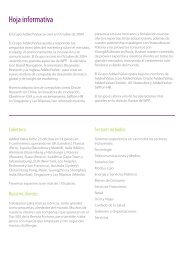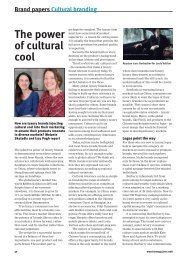global market bias: part 1- color - Added Value
global market bias: part 1- color - Added Value
global market bias: part 1- color - Added Value
You also want an ePaper? Increase the reach of your titles
YUMPU automatically turns print PDFs into web optimized ePapers that Google loves.
The Global Market Bias research<br />
project is a series of studies examining<br />
visual and brand language around the<br />
world. It is a collaboration among three<br />
companies with strong credentials<br />
in <strong>global</strong> <strong>market</strong>ing, branding, and<br />
design–bringing together cultural<br />
expertise from Cheskin, the <strong>global</strong><br />
online research community from<br />
MSI-ITM, and the vast CMCD Visual<br />
Symbols Library.<br />
In our collective 93 years of experience<br />
with companies and cultures the world<br />
over, we’ve developed an appreciation<br />
for the differences between people<br />
— differences rooted in age, gender,<br />
and culture. Yet, with increasing<br />
<strong>global</strong>ization, we can’t help but wonder:<br />
in spite of historical cultural beliefs, are<br />
people starting to see the world in a<br />
somewhat uniform way? Might a <strong>global</strong><br />
visual language be developing? To find<br />
out, we launched a multi-<strong>part</strong> research<br />
series to consider how similar (or not)<br />
we really are.<br />
Our first installment explores the<br />
associations various regions make with<br />
<strong>color</strong>. Subsequent studies, already<br />
under way, will delve into the viability of<br />
non-celebrity spokespeople of varying<br />
cultural backgrounds, and the degree of<br />
brand elasticity around the globe.<br />
Introduction<br />
The Global Market Bias Research Series<br />
2 Cheskin | MSI-ITM | CMCD Visual Symbols Library | 2004<br />
Why Explore Color?<br />
People associate <strong>color</strong>s with emotions,<br />
products, companies, and even<br />
countries. Choosing appropriate and<br />
inspiring <strong>color</strong>s is especially critical<br />
when dealing with multicultural<br />
<strong>market</strong>s. In some cases, <strong>global</strong> brands<br />
have successfully created universal<br />
<strong>color</strong> associations. Coca-Cola is red,<br />
no matter where you go. But in other<br />
cases, there are vast differences in<br />
what <strong>color</strong>s mean to people. Certainly,<br />
studies on <strong>color</strong> abound. In fact, 50<br />
years ago, Louis Cheskin published<br />
“The Color Guide for Marketing Media”<br />
and wrote “Colors: What They Can<br />
Do For You” prior to that. So, looking<br />
forward while looking back, we embark<br />
on a new <strong>color</strong> study.<br />
Study Methodology<br />
An online survey reaching 17 countries<br />
obtained 12,929 interviews, the<br />
largest geographically balanced study<br />
on <strong>color</strong> to date. In order to qualify,<br />
respondents could not be <strong>color</strong>blind.<br />
Online interviews were conducted from<br />
June 28, 2004 to July 9, 2004, using<br />
PlanetPanel ®, a proprietary <strong>global</strong><br />
community developed and managed<br />
by MSI-ITM. The countries <strong>part</strong>icipating<br />
in this study included: Australia,<br />
Belgium, Brazil, Canada, China,<br />
France, Germany, Italy, Japan, Korea,<br />
Mexico, the Netherlands, Russia,<br />
Sweden, Spain, United Kingdom, and<br />
United States.<br />
The online survey first asked<br />
respondents to pick a favorite <strong>color</strong>,<br />
then continued by focusing on eight<br />
<strong>color</strong>s — red, blue, green, purple,<br />
orange, yellow, black, and white.<br />
Participants were asked to rate the<br />
<strong>color</strong>s in terms of their association with<br />
certain attributes, products, companies,<br />
and countries.





